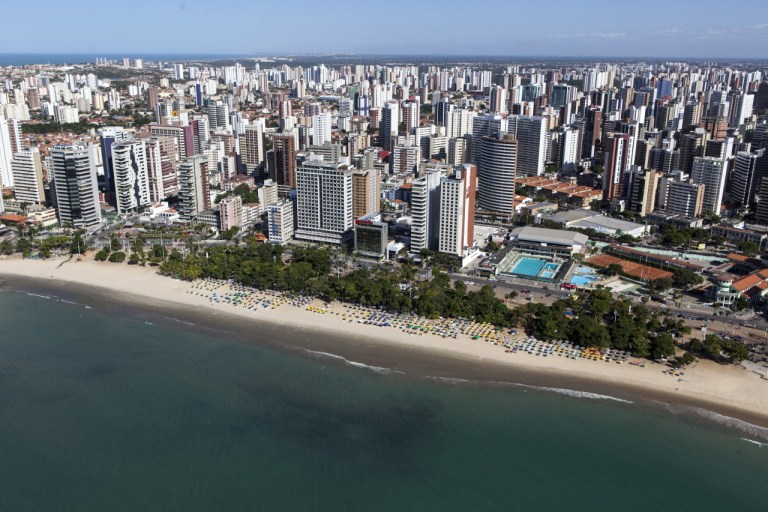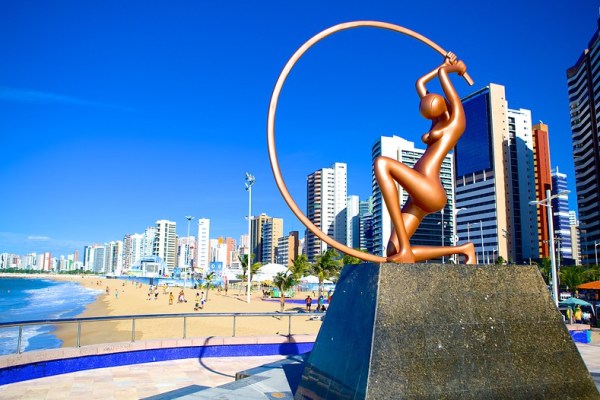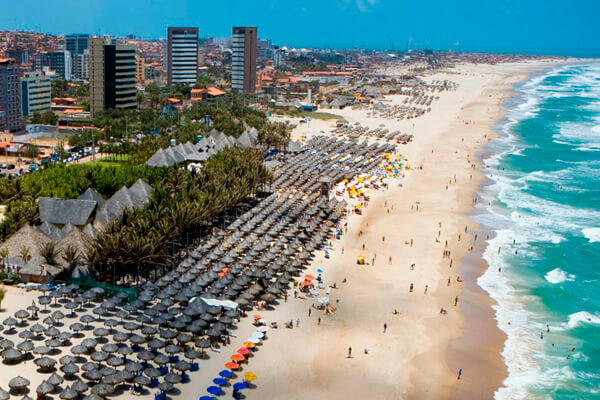
Brazil’s economy, ranked in 2017 as the eighth largest economy in the world, has a gross domestic product (GDP) of 6.55 trillion Real, or 2.1 trillion US dollars, according to International Monetary Fund (IMF) estimates. It is also the second largest economy in the American continent, behind only the United States. According to the report of the International Monetary Fund of 2017, Brazil is the 65th in the world in terms of GDP per capita (which is the value of goods and services produced in a country in a given year, divided by the population of that same year).
Brazil is one of the so-called emerging powers. It is the “B” of the BRICS group and a member of several economic organizations such as the Common Market of the South (Mercosur), the Union of South American Nations (UNASUR), the G8 + 5, the G20 and the Cairns Group. It has hundreds of trading partners and around 60% of the country’s exports are manufactured and/or semi-manufactured products. Brazil’s main trading partners in 2017 were Mercosur and Latin America (25.9% of trade), the European Union (23.4%), Asia (18.9%), the United States (14.0%) and others (17.8%). Some economic experts, including analyst Peter Gutmann, say that by 2050 Brazil may statistically reach the standard of living observed in 2005 in the Eurozone countries. According to a Goldman Sachs forecast, in 2050 Brazil will reach a GDP of 11.3 trillion dollars and a GDP per capita of 49 759 US dollars making it the fourth largest economy on the planet.
The country has a sophisticated technological sector and develops projects ranging from submarine to aircraft manufacture (Embraer is the third largest aircraft manufacturer in the world). Brazil is also involved in space research. It has a satellite launch center and was the only country in the Southern Hemisphere to be part of the team responsible for building the International Space Station (ISS). It is also a pioneer in the development of a biofuel – ethanol produced from sugarcane. In 2008, Petrobras subsidiary, Petrobras Biocombustível, was set up with the main objective of production of biodiesel and ethanol from renewable sources, such as biomass and agricultural products.
Brazil has the second largest industrial park in the Americas. Accounting for 28.5% of the country’s GDP, the numerous Brazilian industries vary from automobiles, steel and petrochemicals to computers, aircraft and durable consumer goods. With the increased economic stability provided by the Real Plan, Brazilian and multinational companies have invested heavily in new equipment and technology, a large part of which has been purchased from US companies.

Ceará is one of the 27 federal states in Brazil. It is located in the north of the Northeast Region and borders on the Atlantic Ocean. Its total area is 148,920,472 km². The population of the state is 9,075,649 inhabitants, according to estimates by the Brazilian Institute of Geography and Statistics (IBGE) in 2018, being the eighth most populous state in the country.
The capital and most populous municipality is Fortaleza, home to the Metropolitan Region of Fortaleza (RMF). Other important cities are: Juazeiro do Norte, Sobral, Itapipoca, Iguatu, Aracati, Quixadá, Caucaia, Eusebio, Horizonte, Maranguape, Maracanaú, Aquiraz and São Gonçalo do Amarante, headquarters of the Pecém Industrial and Port Complex. The state has 184 municipalities in all.
It is currently the eleventh richest state in the country and the third richest in the Northeast. The capital, Fortaleza, is the municipality with the largest GDP in the Northeast, and ninth largest in the country. Ceará offers the best quality of life in the North-Northeast. Ceará is home to one of the largest water parks in Latin America, The Beach Park. Situated on the beach of Porto das Dunas, Beach Park welcomes around 1.5 million visitors a year. The state also houses Brazil’s fourth largest soccer stadium, the Governador Plácido Castelo Stadium (Castelão), which has a capacity of more than 64,000.
The state is known nationally for the beauty of its coastline, religious festivals and is famous for being a center of comedic talent. The wooden rafts, still common along the coast, are considered one of the recognizable symbols of the people and culture of Ceará. Ceará is also known as the “Land of Sun”, possibly in reference to the large number of sunny days?, but in reality, due to journalist José do Patrocínio coining the title “the Land of Sun” on account of the state being the first of the federation to abolish slavery in 1884, four years before Golden Law.
Ceará has one of the largest and most important coastal strips in the country from a tourism perspective. Extending for almost 600 km, you can see mangroves and restingas, typical coastal vegetation and non-vegetated areas covered by dunes. Average temperatures are around 32 ° C and sea water is around 28 ° C. The coastal plain has a diverse geography which means that the state has many beaches with coconut trees, dunes and multicolored cliffs.
The most internationally renowned beaches in Ceará are Praia do Futuro, Jericoacoara Beach, Canoa Quebrada Beach, Cumbuco Beach, Baleia Beach, Flecheiras Beach, Lagoinha Beach and Porto das Dunas Beach.
Some of the important cultural areas of the state are: Casa de José de Alencar which houses the Museum of Income, the Museum of Anthropology, Pinacoteca Floriano Teixeira and Braga Montenegro Library, Museum of Image and Sound of Ceará, Museum of Ceará , Theatro José de Alencar, one of the most important examples of art nouveau architecture in Brazil, the Dragão do Mar Center of Art and Culture, which houses the Museum of Contemporary Art of Ceará and the Ceará Museum of Culture, Sacro Museum São José de Ribamar and Dom José Museum both important museums of sacred art in Brazil, Cachaça Museum, and the historical centers of the cities of Sobral, Icó, Aracati and Viçosa do Ceará.
Other notable attractions are: Public Archive of the State of Ceará, Governador Menezes Pimentel Public Library, Juvenal Galeno House, Bom Jardim Cultural Center, Dragon Sea Center of Art and Culture, Thomaz Pompeu Sobrinho School of Arts and Crafts, Sobrado do Doutor José Lourenço, Ceará Academy of Letters, Ceará Institute, Cariri Cultural Institute, Inhamuns Museum, Sobralense Academy of Studies and Literature.

Located in the northeastern region of the country, Fortaleza is a Brazilian municipality and has Ceará as its state capital. It is situated 2,285 km from Brasília, the federal capital. The motto of Fortaleza, seen in its coat of arms, is the Latin word Fortitudine, which, in Portuguese, means “strength, valor, courage”.
Fortaleza is located on the Atlantic coast at an average altitude of sixteen meters with 34 km of beaches. It covers 313,140 km ² and in 2018 had an estimated 2,643,247 inhabitants. It has the highest population density of all the state capitals in Brazil, with 8,390.76 hab / km². It is the largest city of Ceará in terms of population and the fifth largest in Brazil. The Metropolitan Region of Fortaleza is the sixth most populous in Brazil and the highest in the North and Northeast with 4,051,744 inhabitants in 2017. It is the northeastern city with the largest area of regional influence and has the third largest urban network in Brazil, behind only São Paulo and Rio de Janeiro.
In 2014, Fortaleza was the twelfth richest city in the country in GDP terms, and the richest in the Northeast, with GDP 56 billion Reals. It also has the third richest metropolitan region in the North and Northeast. It is an important industrial and commercial center for Brazil, with the eighth largest municipal purchasing power of the nation. According to the Ministry of Tourism, the city reached the heights of being the second most desired holiday destination in Brazil and the fourth most visited Brazilian city. It is the closest Brazilian capital to Europe, 5,608 km from Lisbon, Portugal.
According to the same census, 1,304,267 inhabitants were women, equivalent to 53.19% of the population, and 1,147,918 were men, representing 46.81% of the total. At the beginning of the twentieth century, there was a marked moment of foreign immigration into the city, especially the Portuguese. Several families of Syrian-Lebanese origin also formed a strong community in Fortaleza at that time, as well as Spaniards, Italians, English and French.
Motivated by leisure and tourism, groups of Portuguese, Italian, Spanish and several other European countries have migrated to Fortaleza. In the 2000 census, 2,562 residents of Ceará were born in other countries. According to the Immigration Office of the Federal Police in Fortaleza in 2013, this grew to around 15,000 foreigners living in the city. In addition, a survey undertaken in 2017 by the Consul General of the United States to the Northeast, revealed that the city of Fortaleza has the largest concentration of american visitors and residents in the region.
At the beginning of the 2000s, amongst the capitals of the Northeast, Fortaleza ranked third. The city’s booming economy is reflected in its purchasing power, the country’s eighth largest, with estimated consumption potential at 42 billion Reals in 2014.
Fortaleza is one of the most popular tourist destinations in Brazil. According to the Ministry of Tourism, the capital of Ceará is the second most desirable tourist destination in the country and has the fourth highest visitor numbers. Large international tourism and travel organisations, such as TripAdvisor, and national institutions such as the Brazilian Association of Travel Agencies, have identified the city as one of the best and most sought after in the country. The popularity of the city for tourists has stimulated the growth of a robust hotel network and entertainment attractions such as beach huts, handicraft shops, water parks, clubs, nightclubs and concert halls. The city has also seen the development of projects such as Acquario Ceará, the third largest aquarium in the world, which is under construction on the edge of the city and the Giant Wheel, which is larger than the London Eye.

Attractions such as the Beach Park theme park, Beira Mar Avenue and its bars, restaurants and music clubs, the beaches of Futuro and Iracema and the Pirata Bar have placed Fortaleza among the Brazilian destinations preferred by Europeans. The highest numbers of foreign tourists visiting the capital of Ceará are from Italy, the United States, Germany, France and Portugal. The city has dozens of consulates and diplomatic representation that assist foreign tourists.
Fortaleza has also developed as an emerging events and business tourism hub in Brazil. Facilities such as the Fortaleza Convention Center and the Ceará Event Center, the second largest in Latin America, have given new prominence to the city by attracting large numbers of fairs, congresses, conferences, conventions, lectures, seminars, exhibitions, concerts and national and international meetings. Fortaleza hosted the Sixth BRICS summit.
The tourist development of Fortaleza is promoted not only by the attraction of events, but also by the annual festivities of the city, such as the Carnival and its courts of Maracatu, the festivals June, Fortal, considered the largest indoor and largest micareta off season carnival party, and Ceará Music, a festival of pop, rock and electronic music. Another traditional event of the city, especially popular amongst young people and locals, is SANA, one of the biggest Brazilian celebrations of Japanese culture.
The current Pinto Martins International Airport, which was built between 1996 and 1998, is located in the geographical center of Fortaleza and is fifteen minutes away from the main business district and the outskirts of Fortaleza. It is the third busiest airport in the Northeast Region and one of the busiest in the country, receiving an average of 1,500 international aircraft and 65,000 domestic aircraft per year. The airport is currently undergoing an expansion program which will increase the number of departure gates from seven to sixteen and the passenger terminal will be expanded from 38,000 m² to 133,000 m². When the project is completed, it is expected the airport will have the capacity to serve 11.2 million passengers per year, a 5 million increase from the 6.2 million passengers passing through in 2014.
There are also plans for the construction of a second airport in the region, in the Pecém area. This new facility will be the hub for cargo and international flights, whilest the Airport of Fortaleza will maintain the domestic flights and private jets.
The gastronomy of Fortaleza is typical of Northeastern Brazilian cuisine serving up traditional dishes such as the baião of two, usually accompanied by barbecue lamb or jerk meat. Seafood is another ingredient of typical Brazilian cuisine. Popular dishes are arraia moqueca and mackerel and snapper fish.
Crab is synonymous with the state. Every Thursday, the traditional “crab” happens, an event in which restaurants, bars and stalls all over the city serve a variety of crab-based dishes. Shrimp and lobster are also widely used delicacies in dishes such as shrimp rice or shrimp dumplings. At the Fish Market in Mucuripe, it is possible to buy a wide variety of fish which can be prepared in neighboring restaurants. The most popular is to buy shrimp and request it to be prepared in garlic and oil. A strong tradition of Fortaleza is the consumption of this delicacy in the home, at dusk on the weekends, accompanying the return of the rafts after a day of fishing.
Varjota, Iracema beach and Beira Mar gastronomic centers offer the most diverse choice of international cuisine. Along with Arabic, French, Chinese, Japanese, Italian, German, Portuguese, Spanish and Swiss restaurants, pizzerias, steakhouses, contemporary and regional cuisine can be found. There is another gastronomy attraction in the south of Fortaleza, on the border with Eusebio, in the “Tapioqueiras” which are restaurants specializing in the preparation of tapioca, another local delicacy.
